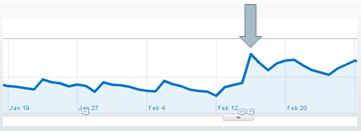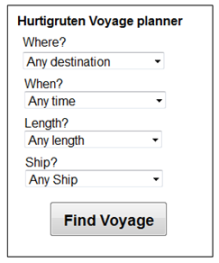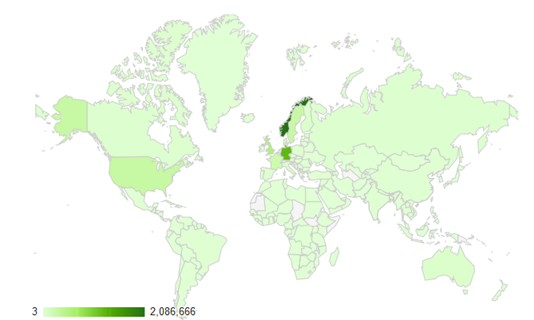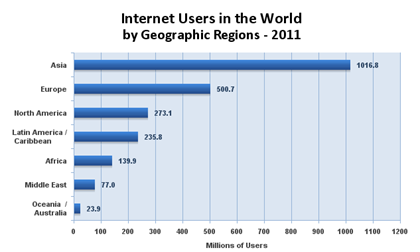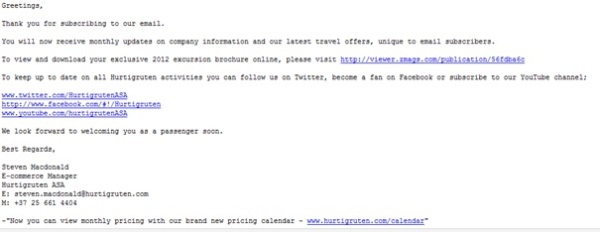2012 in review
The WordPress.com stats helper monkeys prepared a 2012 annual report for this blog.
Here’s an excerpt:
600 people reached the top of Mt. Everest in 2012. This blog got about 5,200 views in 2012. If every person who reached the top of Mt. Everest viewed this blog, it would have taken 9 years to get that many views.
10 lessons I’ve learned at Hurtigruten
September, 2012 marks my third year at Hurtigruten, the longest tenure in my career. However, I will be leaving the company on 31st August to seek new ventures. Hurtigruten is an international brand with a multi-cultural workforce. Ive learned a lot, and this blog post will highlight the most important lessons I’ve learned.
1. Be Prepared
In October 2010 I was asked to present to our most important partners progress made at our reservation centre. Although I am not responsible for the operations at the reservation centre, it was a chance for me to meet our partners and present in front of more than 30 people, including management. I didn’t prepare and tried to read each point slide for slide. It was embarassing and I failed. From that point on, I always made sure that with each presentation I was fully prepared.
2. Know your data
Being E-commerce Manager, I’m expected to know the current online sales status. By reporting daily to myself on the previous days/ weeks sales, I was always up to date on how well we are performing online. Reporting to myself lead to my weekly report being distributed to senior management and the weekly report is now sent to more than 45 people each Monday. I became the online sales expert.
3. Stay consistent with meetings
When working internationally, people are always busy at different times of the day. Karl Philip Lund introduced bi-weekly global web meetings and for more than two years they became a priority for those working in the global web team. In these meetings, we shared updates and communicated with each other – Both important when we only meet in person once per year. Having consistency ensures it becomes prioritied and communication flows a lot easier.
4. Work hard – Always
There is no substitute for hard work and getting thing’s done. I’m fortunate as I enjoy my work but I made sure that I never became complacement. If someone wanted a job doing, I made myself available. Very few people actually do what they say they will, so it’s easy t become successful by doing what you say. Working hard helped me get to where I am today. I will continue working hard.
5. Respond to emails
A job description rarely includes „answering internal emails“, yet some of my colleagues at Hurtigruten receive more than 100 emails per day. This is roughly 40-50% of the work week reading and answering emails. My inbox is always at 0. I respond to emails immediately and add the task to my to-do list (to get done the same day). This could be due to my background as a customer service agent and response times but I try to answer emails within an 30 minutes, unless traveling. This improves communication and the sender knows they can reply on you. You don’t want to be the person „that never responds to emails“.
6. Candor
Being honest in work almost sounds like a given, yet it is surprising the amount of people who do things because they are told and do a poor job instead of being honest and being candid. A prime example is that I was not comfortable working with API. By being upfront, the role was give to a colleague who was interested in API. I am much more interested in online marketing and direct online sales. This is where I excel.
7. Let your team do what they want
I don’t mean let them run wild and abuse the freedom, but there are always 101 things to get done in anytime of department. By letting your team drive activities they are interested in, results will come. A good example if a former team member being interested in video editing. The end result was videos on the Hurtigruten websites, which when tested against pages that didn’t have video, we saw a 127% increase in initiated bookings. Another example is email marketing, which was lead by a former team member Nicole Simon implementing Silverpop, which is now being used two years later. Let them run full speed ahead and you will see great results.
8. Never stop learning
Each morning, I read the latest news and blog posts on online marketing and conversion rate optimization. I read monthly white papers on social media marketing, success stories written on SEOmoz and attend webinars from SeeWhy. You can succeed, your business can succeed, the stories and „how to“ guides are out there. I enjoy learning new things and try new tools. Learning is fun.
9. Implement like hell
Jack Welch’s quote „pick a general direction and implement like hell“ is now infamous at Hurtigruten. It has been the backbone of the online success and I will carry it on wherever I go. When people hear Implement like hell, it can appear stupid or silly. It’s works – and Hurtigruten online sales is proof of this.
10. Share success stories
Another famous quote Jack Welch has made is to share success stories and celebrate. When something good happens such as a record web visits day or a new high for open rates in email marketing, celebrate it and share the success. It boosts morale and is good for the team and company. Don’t be afraid to take credit for the success either. If you did something that you are proud of, celebrate it.
It’s been an amazing three years and a lot of fun learning and experiencing new things. I’ll continue blogging on a new blog platform, Tribes.no. Thanks for being part of the Hurtigruten’s success and hope that you continue to implement like hell!
If you liked this post, you may enjoy reading:
Booking engine update July 2012
On Wednesday, 4th July Hurtigruten released a new version of our agency booking solution (B2B) and consumer booking solution (B2C). The focus for the release is to improve the booking engines to match the new web design and usability and the launch of arrival and departure packages.
Fixes set for the release (B2X version 3.4) include:
- Launch of arrival/ departure packages for 2013 sailings
- Google Analytics E-commerce tracking for www.hurtigruten.com
- Advanced functionality to search by ship, ship type and length of voyage
- Deckspace capacity display (Hubro) on web for last minute bookings
- Booking box enhancements (new web design) to include tours
- 46 bug fixes including 2013 tours, navigation and pricing
The first booking engine release of the year went live in March 2012. Since then we have had an aggressive roll out plan and implemented the following functionality:
- Norway and Explorer 2013 sailings
- Improved booking box on front page
- Arrival/ Departure packages 2013
- Google Analytics E-Commerce tracking
- New booking engine design
- 1893 Ambassador discount
- Shore excursions 2013
We now enter a development freeze due to the summer vacation period. When development resumes in late August, we will continue our focus in getting all products for sale online with port-to-port return trips, meal and upgrade handling and the option to add/ modify excursions to existing bookings.
What do you think of the new improvements that have been made? Post your comments below.
In 2011, Hurtigruten improved the online user experience by introducing key functionality (booking box) on the home page. Since then, continuous improvements have been made and documented, such as the results of what happened when we move the functionality above the fold and how the improvements increased sales online.
Since launching the booking box, we have continued to increase online sales and improve the user experience. The blog post will review the impact to online sales of each improvement.
February Week 2, 2011
On February 15th, 2011 Hurtigruten launched key functionality on the home page. The booking box was implemented below the fold but the results were immediate as initiated bookings increased by more than 173%. Online bookings increased by 28%.
Increased initiated bookings
June Week 1, 2011
On June 1st, Hurtigruten moved the placement of the booking box to above the fold. The reason for this was that during usability tests that were ran in March, 2011 only 2 of the 10 testers found the booking box on the home page. The results were immediate as online bookings increased by 4%.
March Week 2, 2012
On March 5th, Hurtigruten implemented a new booking box after extensive research into 2011 sales data. The new booking box included both passenger selection and cabin requirments, thus giving the user a more exact price earlier in the booking process. The results were immediate and online bookings increased by 42%.
June Week 3, 2012
On June 18th, Hurtigruten launched a new version on the website in Norway. The improvements were based on the results of the usabiity tests in March 2011. With a new web design and improved booking box, online bookings increased by 15%.
Booking box design improvements since Feb 2011
[Left booking box on both above and below the fold]
In September 2012, further improvements will be implemented as we introduce tours (currently live on the German site) and a five day calendar view on the search results. These improvements are in line with feedback from usability tests we have performed.
Mock-up of new booking box
The current booking box is targeted towards Hurtigruten’s Norwegian market. However, during the last 12 months, more than half of the total web traffic has been from countries outside of Norway. Most international customers do not know where Kirkenes or Bergen is, and most travellers do not know their specific travel date. This information is critical in the decision making process. Thefore, an international booking box will be created for non-Nordic web visitors. We expect this improvement to increase conversion rate.
Prototype of International booking box
Gerry McGovern once said „I can’t think of a successful website I’ve dealt with hasn’t had a continuous improvement management model“. In 16 months, Hurtigruten have continued to improve key functionality and online sales have increased tenfold. We will continue with our improvements.
All the sales information in this blog post have been presented in publicly available reports.
Do you have any success stories on continuous improvement? Do you have any suggestions on how we can improve the booking box further? Suggestions are welcome in the comments box below.
New website launch for www.hurtigruten.com
In 2011, Hurtigruten ran a full scale usability test with Spotless Interactive in the UK, Germany and Norway. The findings were presented in April 2011 and during the past 12 months we have been working hard on implementing the web improvements. On Thursday, 18th June the new design went live in Norway and today we will launch the first of our English websites with www.hurtigruten.com. The focus for the new website is to deliver a greater user experience.
Here is an overview of the improvements:
- New front page design with map, video and links to the most popular web pages
- Improved booking box on the front page and all voyage pages
- Tabbed navigation menu for products, schedules and experiences
- Brochure and Newsletter sign-up on the front page
- New sections with Seasons and Experiences
- Richer content for Norwegian and Explorer voyages
One of the biggest changes made to the Hurtigruten web is that all Hurtigruten websites will now have the same layout and structure. Websites in Germany, France and the UK will be launched during the summer.
The new design is part of a three-phase improvement package based on the usability test results. The next release is scheduled for the fall with focus on presenting richer product content.
A more detailed blog post on the process of changing the URL structure, redirecting old content to new content and of the website launch and impact on traffic will follow shortly.
What do you think of the new website? Feel free to submit feedback and suggestions in the comments box below.
Booking engine update June 2012
On Thursday 21st June, we released a new version of our agent booking solution (B2B) and our consumer booking solution (B2C). The focus for the release was to improve the online experience for our travel partners by making it easy to book as well the launch of our European Explorer packages.
Fixes set for the release (B2X version 3.3) include:
- Launch of European Explorer cruises 2013/14
- 1893 Amabassador discount and integration
- Last minute booking webform for bookings within three days of sailing
- Optimized booking solution for mobile and tablet users
- Special request & notes fields added for additional requests
- Preferred contact method can be selected between phone, email or mail
- Print ticket functionality for 2013 sailings available in B2B
- Big fix to payment issues in ‘Opera’ browser
- And a total of 63 bug fixes for inclusive tours, find booking functionality and cabin selections
How do you feel we are progressing with our development? Is there anything that we should prioritize and implement before the summer? Share your suggestions in the comments below
Translating your website has never been easier; whether you need your entire website translated or just a simple sentence there are now thousands of companies waiting to do business with you. The translation industry is a multi-billion dollar business and while 70% of Internet users do not speak English, limiting your language selection means limiting your online sales. This blog post will review three ways to translate your website using human translation.
1. Inhouse translation
A number of companies I’ve worked with manage translation inhouse where both sales and marketing teams share the workload and support website and email translation. Although this is the cheapest alternative, maintaining consistency is highly difficult as several copy writers are involved and with a combination of various writing styles, this could result in a lackluster final product.
Tip: Have dedicated translators to provide translation support for each language to keep content consistent.
2. Outsourcing to a translation agency
If your marketing director allocates budget for translation, outsourcing translation is a great way to relieve the workload of your internally staff. However, depending on the number of languages you support, outsourcing can be costly and you will always need to internally proof-read and sign off before you publish the content.
Tip: Keep a glossary of key terms that be used repeatidly for maximum translation accuracy.
3. Translation API
Translation API might be a new concept but it has all the benefits of inhouse translation and outsourcing. By integrating with your CMS (Content management system), translation API can help launch products globally automatically and without the increased costs of translation agencies.
TIP: Make sure you sign-off content before it goes live to ensure 100% translation context accuracy.
Where does your web traffic come from?
In 2011, more than 170 countries visited the Hurtigruten websites taking the total web traffic to more than five million visits. Map below taken from Google Analytics
The map provides further insight as to where web traffic comes from. In fact, in 2011 only a small number of countries did not visit the Hurtigruten global web at least once. These contries include North Korea, Mauritania, Chad, South Sudan, Somalia and Papau New Guinea.
Hurtigruten now has more than 21 websites in 15 languages. The majority of traffic came from our bigger markets; Norway, Sweden, Germany, UK and the US but as travel and tourism in Scandinavia continues to grow, the number of foreigners longing to visit will increase and being able to support their preferred language will be a huge competitive advantage.
The curent state of translation and localization
In 2001, a report by META Group ranked the US, Finland, Iceland and Canada amongst the highest e-commerce potential. More than a decade later, and e-commerce has radically changed. The fastest growing market online is now Asia and e-commerce spending is expected to reach more than $8 billion in 2016, up from $1 billion in 2012. Chart taken from Internet World Stats
Further data on the potential future of localizing your websites:
- There are 2.3 billion internet users online
- 36% of the Chinese population are online
- Only 8% on Indians are online
- Arabic speakers online increased 2500% since 2001
- As of 2012, only 14% of Internet users live in the US
- More than 75% of the total population will be online by the end of the year
- 83% of internet researchers will make at least one purchase online in 2012
Chart courtesy from Mary Meeker and KPCB
This data is also evident for web traffic to Hurtigruten and visits from emerging markets continues to increase. For example, web traffic from India increased by 51% between 2010/11 and is expected to increase by more than 69% in 2012 and Chinese web traffic grew by 28% between 2010 /2011 and is expected to increase by more than 12% this year.
Going global provides a better user experience
There are challenges related to being a international brand such as legalities, organizational and operational. The web is global and e-commerce spending is only going to increase. Supporting buyers in their native languages to make them feel safe and secure will provide a better user experience and if you have an e-commerce store that is currently only availabile in English or your native language, expanding will directly increase your online sales.
Building high quality email subcription lists
Building a subscribers list is something that takes a lot of time and focus. Email marketing is one of the most effective marketing channels and 77% of online consumers prefer email over any other channel for recieving promotional material. Instead of buying lists, you can build your list organically and get high quality leads interested in your product – This means better traffic and increased sales.
In March 2010, Hurtigruten.com sent out a newsletter to 14 subscribers – To deliver on a promise for those who signed up for monthly promotional emails. Today, the list has grown to a lot more but by building the list and keeping it personal we have seen our email marketing open rates and click-through rates improve by as much as 400%.
Make it easy for visitors to sign up
Up until 2011, Hurtigruten was much more focused on local markets so in in 2010, Hurtigruten.com launched a newsletter sign up page in a bid to build up its own subscriber list.
We kept the sign up process very simple and only requested information that would improve the email experience for our subscribers such as email address and interests (Norway, explorer, special offers).
Emphasize why users should sign up to your newsletter
Since launching the webform we have continually tested copy and email fields as we look to make it easy to subscribe. One of the most recent improvements we made to the page was to emphasize the benefits of signing up, which lead to a huge increase in sign ups and we now have a 30% conversion rate on the page. Here is what you can expect when signing up to receive monthly newsletters:
- Promotions and discounts for early booking offers
- No invoicing fee (when booking online)
- Last minute deals for short distance departures
- Be the first to know about brochure and catalogue launches
- Invitations to Hurtigruten events and travel fairs
Highlighting the benefits for the user has been very successful at Hutigruten as we saw initiated orders increase by 193%. In addition to improving copy, we also moved the page placement of the sign up form further into the site, a move that goes against best practice for e-commerce – Yet, by doing this we found the number of visitors to the page increased by 75%:
Send personalized real time welcome emails to subscribers
After launching our sign up form, we quickly found users signing up to receive emails. Our „thank you“ page was not ideal so in an attempt to improve the experience, I sent a personal thank you email to each subscriber. Below is a copy of the email sent from my Hurtigruten email address:
The email thanks the user for subscribing a d informs them how often they will receive promotional emails from Hurtigruten. The email also includes links to our Facebook, Twitter and YouTube pages.
We have improved the copy within the email as well as the signup page. The personalized newsletter now contains a link to the exclusive online excursion brochure, which is not available in print format. We’ll also be adding links to our Pinterest page and online booking system.
The results for Hurtigruten’s email marketing activity
According the MailChimp’s industry benchmark report, the average open rate in the travel industry is 14% and click-through rate is 2.7%. The results of building an organic list froms scratch have been staggering as Hurtigruten.com continually see open rates of 45% and click-through rates of 18%. And over the course of two years, we have seen less than 15 people unsubscribe from our list!
One on one marketing is here to stay and as the web becomes more personal, building organic lists is a great opportunity to build relationships and increase sales.
Have you seen success from building your organic lists? Is there anything I have missed that is a key element in increase subscription rate? Comments and suggestions are welcome below.
Inbound marketing in a post-penguin world
Do the words over-optimization, link-warnings, penguin and panda make you feel nautious? During the past 12 months, have you been scrambling around after each Google update as you try to ensure your sites do not become de-indexed or fall off the first page SERPs (also known as Search Engine Results Page)? If so, you are not on your own as Google has severely stepped up its algorithms to put the user first, and our SEO, well… far behind.
Since February 2011, Google has been on the offensive and penalizing sites that overly-optimize to rank on the first page of the SERPs. Although not entirely due to the NY Times article that exposed JCPenney, the focus on better content for the user has increased since the article was published. What JCPenney did was purchase thousands of low quality links that helped them rank high in SERPs for general terms and thus, increased both traffic and sales. These tactics provided a short-term impact for sites to rank high in Google – You can read the list of changes during the last 12 months (courtesy of SEOmoz).
Google’s update and SEO tricks that no longer work
In short, SEO’s have had to deal with a total of 17 updates in the last year. However, these updates have not only affected black-hat SEO tactics but on the opposite end of the scale, as the updates also penalize extensive white-hat SEO – Meaning SEO’s have had to change the way we may work. Here is an outline of what has been affected with the updates and what activity will be penalized by Google:
- Article marketing
- Over optimization and keyword stuffing
- Below the fold content/high bounce rates
- Link spam/ link farms
- Excessive exact match anchor text
- Use of blog and content networks
Any attempts of SEO spam and to cheat the Google algorithms will be penalized. Hurtigruten has been slow to adopt a global SEO strategy and so far, we have been fortunate to not be affected by the Google updates. However, this is not an anti-black hat or pro-white hat post and the reason why we have not been affected by the Panda/ Penguin updates is largely due to pure luck!
An area that has impacted Hurtigruten more than we had anticipated was the update in October 2011 to make search more secure. Although the impact was not immediate, we have seen an increase in (not provided) keywords in Google Analytics since the Venice update.
The update has affected more than 35,000 visits, which is 5% of total search traffic. However, it’s safe to assume that the traffic came from brand related search terms as the top 15 keywords in 2011 were all brand related.
Avoid the Google penalty and focus on user experience
Many of the sites that have been hit are subject to black hat tactics. If you have always maintained a long-term vision for your SEO, then chances are your sites have been largely unaffected. Inbound marketing now has senior management focus at Hurtigruten. Some of the ways to avoid being hit by Google are as follows:
Keep your content fresh
- Updating our home page (images, listings) weekly with new content
- Bi-weekly blogging on our web blog hurtigrutenweb.wordpress.com
Combine SEO with social
- Guest posts for websites on online marketing topics and recruiting travel writers for the ships blog
- Increased social sharing on Pinterest, Facebook and adding social sharing buttons to the website
Improve the user experience
- Deep linking the top landing pages and improving navigation to reduce bounce rates
- Get the basics right with page titles, meta descriptions and headers
Hurtigruten have a long way to go if we want to compete with the best cruises in the world in the SERPs. We now have a healthy view on SEO and are in the process of an SEO audit. Being in the travel industry, we are always going to be content rich and as Google continues to focus on the user experience, this may give us a slight advantage. However, as Google continues to update it’s algorithyms (including the new knowledge graph), I’m not sure how long this slight advantage will last.
How have your sites reacted since the launch of Panda in 2011? What are you working on to avoid being penalised by Google? Comments and suggestions are welcome below.
Learning points from leading Facebook-pages
Facebook went public last week and there is alot of hype around the social utility company. At the same time companies are discovering how they can use Facebook to engage customers and increase sales!
Alot of people see Facebook as an ad free service where you can communicate with friends and family! Going forward, Facebook needs to find a balance between being a useful service to users and to make money for investors. Google has managed to do this. It remains to see if Facebook can do the same!
Background: The Norwegian case
The Retail chain Enklere Liv has during the last eight months acquired more than 100,000 fans on Facebook. In September 2011, they had approx. 1700 fans and in May 2012 they passed 100,000 fans combined in Norway and Sweden . This places Enklere Liv on the top 25 list of brands on Facebook in Norway .
When you have 100,000 fans, you quickly discover that Facebook is becoming a key marketing channel. Each post on Facebook means sales. Small adjustments can have an enormous impact on response rates. The experience with the retail chain made me interested in learning more about what companies should post on Facebook to engage fans!
Research & Conclusions
To avoid having to reinvent the wheel, I found research on the topic. Momentus Media has studied the 20,000 leading Facebook pages. Here is a summary of their “discoveries”
- When should you publish on Facebook?
Short answer: Weekends and off-peak times provide the highest engagement rates - How often should you publish on Facebook?
Short answer: Publish as often as you want! (According to Facebook, each status update is only seen by approx. 16% of your fans). - What kind of content engages the most?
Short answer: Pictures engage most. - Should I actively ask fans to do something (like, comment, share)?
Short answer: YES! Asking people to like a post increases the engagement level by 216% - Should I ask questions to my fans?
Short answer: Questions do not increase the engagement levels, but it increases the number of comments. - How long should my status updates be?
Short answer: Long messages generate more engagement than short status updates. - How long does a status update last in Facebook feed?
Short answer: 50% of clicks occur within 1 hour. 90% occurs within nine hours
Click “like” below and tell us your best tips regarding status updates on Facebook?
This is a guest post by Karl Philip Lund. KP works with Enklere Liv.

